If you’re trying to improve your physique or get stronger with dumbbells, then you’ll need to choose the right dumbbell weight to build muscle safely and effectively.
The average male beginner requires a dumbbell weight that is at least 10% of his body weight to build muscle. This equates to 15lb (7.5kg) dumbbells for a 170lb man. The average female beginner requires 5% of her body weight, equating to 7.5lb (4kg) dumbbells for a 150lb woman.
This information was important in helping me to choose the ideal weight when I was looking for dumbbells to build muscle at home with.
But you may be just starting at the gym and just need to know how much weight to lift.
Regardless of your reason, my research and experience will help you choose the ideal dumbbell weight for your needs and goals!
Let’s get stuck in.

- Quick Summary: Looking For The Best Dumbbells To Build Muscle?
- What Dumbbell Weight Do You Need To Build Muscle?
- Minimum Beginner's Dumbbell Weight To Build Muscle
- What's The Ideal Beginner's Dumbbell Weight To Build Muscle?
- How Heavy Should Dumbbells Be For Long-Term Muscle Gain?
- Will The Following lb/kg Dumbbells Help You Gain Muscle?
- How And When To Increase Dumbbell Weight To Build Muscle
- Can You Build Muscle With Just Dumbbells?
- Product Recap
- Conclusion
Quick Summary: Looking For The Best Dumbbells To Build Muscle?
I use and highly recommend the PowerBlock Elite and Flybird bench setup.
It’s not the cheapest setup out there, but it provides most people with more than enough weight to keep building muscle well into the advanced stages of training (you’ll get years of progression)!
| Product | Brand | Description | Prime | Buy |
|---|---|---|---|---|
Top Top
Top
Top
Top Top
Top
Top
Top | PowerBlock | BEST heavy adjustable dumbbell. 2.5-50lbs with the option to upgrade to 90lbs using addon-kits. | PrimeEligible | Check Amazon Price |
 Top
Top
Top
Top Top
Top
Top
Top | Yes4All | BUDGET adjustable dumbbell alternative. Up to 100lbs but with less weight increments compared to PowerBlock. | PrimeEligible | Check Amazon Price |
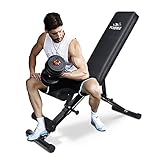 Top
Top
Top
Top Top
Top
Top
Top | Flybird | Fully-adjustable flat/incline/decline weight bench to isolate different muscle regions. | PrimeEligible | Check Amazon Price |
 Top
Top
Top
Top Top
Top
Top
Top | BalanceFrom | High-density foam mat to protect your floor and bench. | PrimeEligible | Check Amazon Price |
What Dumbbell Weight Do You Need To Build Muscle?
In order to build muscle, it is recommended to use a dumbbell weight that challenges the lifter for 8 to 12 repetitions per set for a given exercise. This equates to approximately 65 to 80% of the maximum lifting capacity (also known as a 1-rep max) for that exercise.
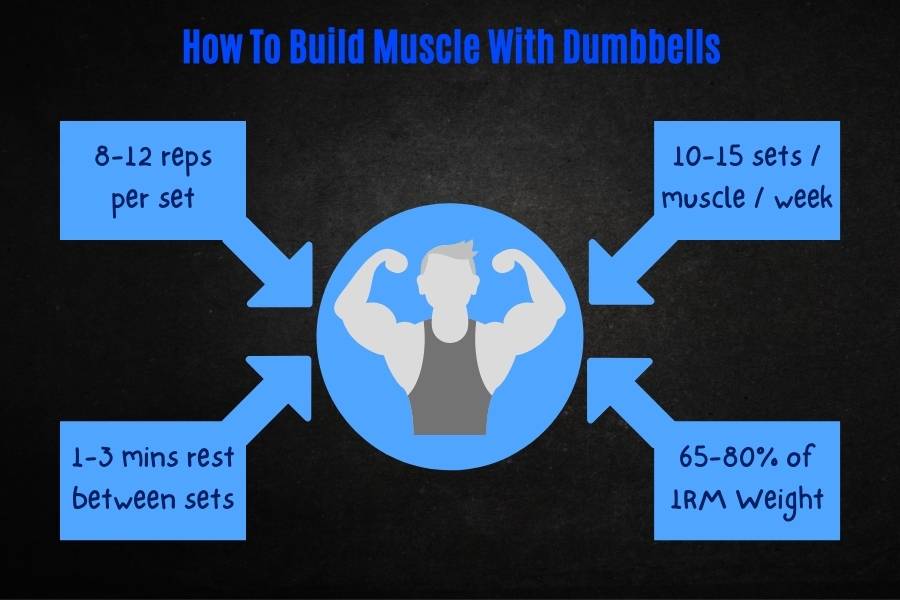
The 8-12 rep range is also commonly known as the hypertrophy (muscle growth) range.
“Training with a moderate number of reps (8 to 12) is the best way to increase lean muscle growth.”
Michael Berg (Personal Trainer) and Brad Schoenfeld (Strength Coach).
Simply put, each set requires you to perform 8 to 12 consecutive repetitions before taking a short rest (typically 1-3 minutes) and repeating another set.
Additionally, you should also aim to complete 10-15 sets per muscle group per week as a beginner to maximize muscle growth.
It’s also crucial that your reps feel “challenging”.
This means the last few reps of each set should bring about muscular fatigue (that lactic burn sensation that makes you think “OK this is getting hard now”).
To ensure this happens, you need to choose a dumbbell weight that’s heavy enough to be challenging but not so heavy that you can’t lift it.
The specific weight required to achieve this sweet spot varies greatly depending on your gender, body weight, body composition, previous training history, and exercise choice.
With that being said, there are generalized dumbbell weight recommendations you can follow to build muscle as a beginner (see next).
Note: a 1-rep max (1RM) is the most amount of weight you can lift for a single repetition for a given exercise. Taking 80% of your 1RM leads to your 8-rep weight and 65% of your 1RM gives your 12-rep weight. You can check out my other article to learn all about RM’s here.
Minimum Beginner’s Dumbbell Weight To Build Muscle
Here’s a generalized recommendation for how heavy your dumbbells should be to build muscle as a male/female beginner:
| Muscle Group | Example Dumbbell Exercises | Typical Beginner Men Dumbbell Weight | Typical Female Beginner Women Dumbbell Weight |
|---|---|---|---|
| Arms | Bicep curl & tricep extension | 5 to 10lbs (2.5 to 5kg) | 4 to 8lbs (2 to 4kg) |
| Shoulders | Lateral raise & shoulder press | 5 to 20lbs (2.5 to 10kg) | 5 to 10lbs (2.5 to 5kg) |
| Chest | Chest fly & bench press variations | 10 to 25lbs (5 to 12.5kg) | 5 to 10lbs (2.5 to 5kg) |
| Back | Reverse fly & row variations | 5 to 20lbs (2.5 to 10kg) | 5 to 10lbs (2.5 to 5kg) |
| Abs | Weighted sit-ups & leg raises | 0lbs (bodyweight) to 5lbs | 0lbs (bodyweight) |
| Legs | Goblet squat & dumbbell deadlift | 20 to 25lbs (10 to 12.5kg) | 10 to 15lbs (5 to 7.5kg) |
Note: These dumbbell weight recommendations are based on a 10-rep weight (10 reps being the median between the 8-12 rep hypertrophy range described above). I calculated these values by taking 1RM data from the Strength Level database of beginner’s dumbbell strength standards and multiplying them by 0.75 (75%).
You can see that the recommended dumbbell weights vary depending on your gender and the exercises you’re performing.
Your body weight will also affect how much dumbbell weight you should lift since heavier people are generally stronger and require heavier dumbbells.
But generally speaking, men require at least 15lb dumbbells and women require at least 7.5lb dumbbells to build total-body muscle at a beginner’s level.
You may also be interested in my other article to learn more about the ideal dumbbell weight for male/female beginners in kg/lbs.
What’s The Ideal Beginner’s Dumbbell Weight To Build Muscle?
The ideal dumbbell weight to build muscle is a minimum of 30lbs (15kg) for men and 15lbs (7.5kg) for women. This is enough to challenge a beginner to build muscle now and continue to gain muscle for at least 6 months. Heavier dumbbells allow for a longer progression period.
You can go to my other post for 9 of the best dumbbells for beginners.
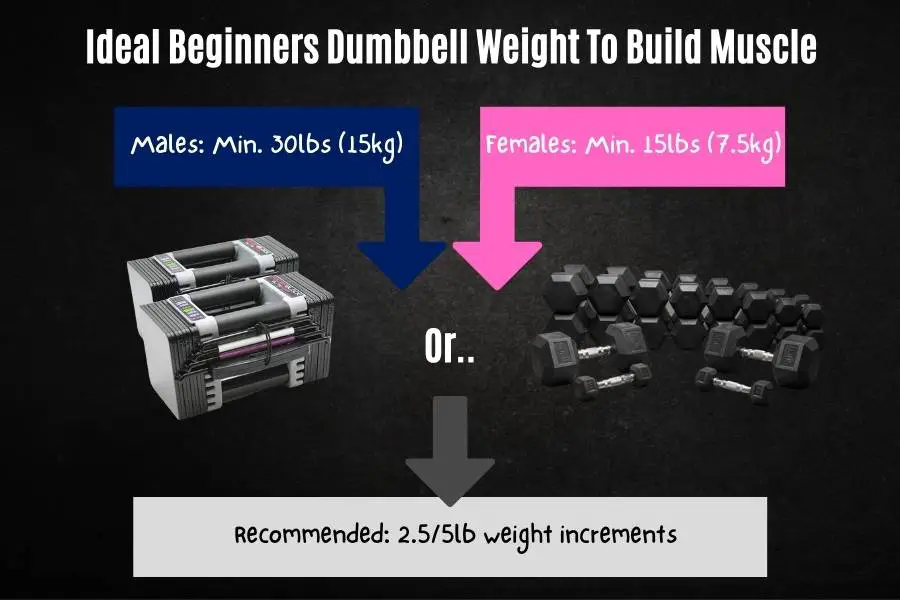
It’s important to note that these recommendations are based on a pair of adjustable dumbbells that contain multiple weight settings in a single unit.
If you’re using fixed-weight dumbbells, you should buy a complete set that provides multiple weight increments.
For example, a male beginner could get a set that goes from 5-30lbs in 5lb increments. A single 30lb dumbbell is no good since it’ll be way too heavy for many of your exercises!
The important thing to note here is the increments.
The smaller the increments, the easier it will be to increase dumbbell weight over time (also known as progressive overload) and continue building muscle.
Generally speaking, dumbbell increments of 2.5/5lbs are ideal for progressive overload.
If you’re training for bigger arms, you may be interested in my other article to find out how heavy your dumbbells should be for bicep curls.
How Heavy Should Dumbbells Be For Long-Term Muscle Gain?
Dumbbells should be heavy enough to continue gaining muscle in the long term. 2x redundant weight is recommended to gain 10lbs of muscle, 3x redundant weight is recommended to gain 20lbs of muscle, and 5x redundant weight is recommended to gain over 30lbs of muscle.
Here’s how heavy your dumbbells should be to gain a specific amount of muscle:
| Target Muscle Gain | Recommended Redundant Dumbbell Weight (Multiple Of Starting Weight) | Recommended Male Dumbbell Weight | Recommended Female Dumbbell Weight |
|---|---|---|---|
| 10lbs | x2 | 30lb (15kg) | 20lbs (10kg) |
| 20lbs | x3 | 50lb (25kg) | 25lbs (12.5kg) |
| Over 30lbs | x5 | 80lb (40kg) | 40lbs (20kg) |
As a beginner, you’ll benefit greatly from the “Newbie Gains” period of rapid muscle growth.
This occurs because your naive muscles are suddenly presented with a great hypertrophy stimulus.
Due to Newbie Gains, you should be able to build your first 10-20lbs of muscle with just 2-3x redundant dumbbell weight.
However, muscle gains become harder with time.
This is why you’ll need around 5x redundant dumbbell weight to build 30lbs of muscle and more.
Please note though- these are estimates based on my own 10-year dumbbell training history that’s seen me gain almost 40lbs of muscle.
In reality, the amount of muscle you’ll build from your dumbbells will vary depending on factors like your diet, training program, discipline, and previous training history.
You may also be interested in my other article to find out what is considered to be light, medium, and heavy dumbbells.
Will The Following lb/kg Dumbbells Help You Gain Muscle?
With all the above points taken into consideration, here’s a dumbbell weight chart to show how effective each dumbbell weight is for building muscle:
| Dumbbell Weight (lb/kg) | Male Muscle Building Potential | Female Muscle Building Potential |
|---|---|---|
| 2lbs (1kg) | Very low | Very low |
| 4lbs (2kg) | Very low | Very low |
| 6lbs (3kg) | Low | Low |
| 8lbs (4kg) | Low | Low |
| 10lbs (5kg) | Low | Moderate |
| 15lbs (7.5kg) | Moderate | Moderate |
| 20lbs (10kg) | Moderate | Moderate |
| 25lbs (12.5kg) | Moderate | Moderate |
| 30lbs (15kg) | Moderate | High |
| 40lbs (20kg) | High | High |
| 50lbs (25kg) | High | High |
| 60lbs (30kg) | High | Very high |
| 70lbs (35kg) | Very high | Very high |
| 80lbs (40kg) | Very high | Very high |
| 90lbs (45kg) | Very high | Extremely high |
- 2-, 4-, 6-, 8-, and 10lb (1-, 2-, 3-, 4-, and 5kg) dumbbells generally have a low capacity to build muscle. They can be used for arm exercises and small lifts like the lateral raise and fly. But they are ineffective for large exercises like the press, row, and squat.
You may be interested in my other post to find out what beginners can do with 10lb (5kg) dumbbells!
- 15-, 20-, 25-, and 30lb (7.5- 10-, 12.5-, and 15kg) dumbbells generally have a moderate capacity to build muscle. They can be used for arm exercises and small isolation-type lifts to an intermediate level. They can also be used to do compound presses, rows, and squats at a beginner’s level.
If you like, you can check out my other post to find out what weight dumbbells you should use to tone your arms
- 40-, 50-, 60-, 70-, 80-, and 90lb (20-, 25-, 30-, 35-, 40-, and 45kg) dumbbells generally have a high capacity to build muscle. They can be used to train the entire body at an intermediate to advanced level with small isolation-type movements as well as large compound-type movements.
You may be interested in my other post to find out how to build muscle with 50 pound dumbbells.
How And When To Increase Dumbbell Weight To Build Muscle
It is recommended to increase dumbbell weight by 5% for upper body exercises and 10% for lower body exercises to continue building muscle. This should be performed when the current number of repetitions is no longer challenging to the lifter.
As an absolute beginner, always start with a comfortable weight that you can lift for 8-12 reps per set.
When the weight becomes easy to lift, you can then begin adding more weight.
Is there a definitive way to tell when your reps are becoming too easy?
Yup!
Generally speaking, you can follow the “2 for 2 rule“:
“If you’re able to do two additional reps in the last set of an exercise, for two weeks in a row, then this is a sign to increase the weight”
Trevor Thieme (Strength Coach)
Thus, the best muscle-building practice involves starting with a light dumbbell weight and progressively adding more weight over time.
Always remember though- good lifting form is just as important as weight.
Never sacrifice form for heavy poundages.
This is called ego lifting and is generally frowned upon because it compromises target muscle activation.
If you’re interested, you can check out my other post to learn exactly how and when to increase dumbbell weight for muscle gains.
Can You Build Muscle With Just Dumbbells?
It is entirely possible to build muscle using just dumbbells. However, it is recommended to use dumbbells that are heavy enough to challenge all the muscles in the body. It is also advised to have a range of weight increments available to effectively train both small and large muscle groups.
So the question becomes:
“Which dumbbells are both heavy and provide good increments?”
If you’re working out at a gym, then there shouldn’t be an issue- a decent gym will have light, medium, and heavy dumbbells with all the increments you’d need.
But if you’re looking to build muscle at home using dumbbells, then you need to choose a good pair.
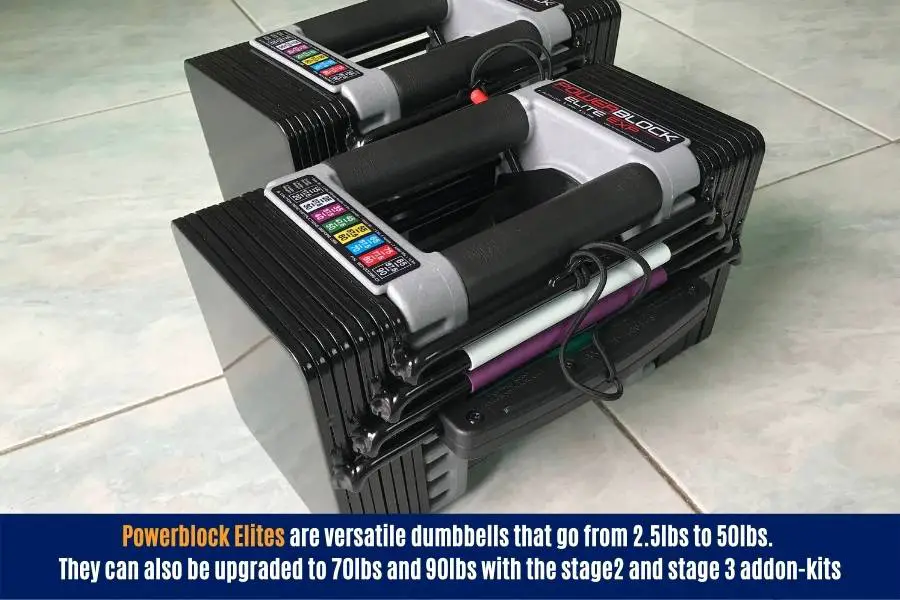
I personally use and recommend the Powerblock Elites (you can see the full specs here).
Each dumbbell contains up to 28 different weight increments.
The base model weighs 50lbs per dumbbell which is enough to take most beginners to an intermediate level (around 2-3 years use).
They can also be retrofitted with these addon kits to take them to 70/90lbs- enough weight to take a beginner to intermediate-advanced levels (around 4-5 years use).
The kits can be fitted whenever you like, so you don’t need to splash all your cash in one go for a pair of heavy dumbbells. Instead, you have the flexibility to upgrade whenever your strength reaches a suitable stage.
Additionally, they are one of the few adjustable dumbbells on the market to feature 2.5 and 5lb increments (perfect for overloading with).
If you like, you can go to my other article to find out the different tyes of dumbbells on the market and which type I think is the best here.
Cheaper Dumbbell Alternatives
UK folks will find the Powerblock Sports (you can see the full specs here) to be much cheaper (they only have 5lb increments though).
- SINGLE DUMBBELL 52.5 LBS TOTAL: ONE 16”x1.15” handle, EIGHT 5-pound plates, TWO 2.5-pound plates, TWO 1.25-pound plates, TWO collars
- CAST IRON WEIGHT PLATES FIT 1.15-INCH STANDARD BAR: Accommodate all standard 1.15-inch handles. Durable cast iron plates covered with black paint finish preventing rust and corrosion for lifetime use
- 14-INCH DIAMOND KNURLED CHROME HANDLE: Constructed of high-quality, textured chrome handle for secure, firm, and non-slip grip
- STAR-LOCK COLLARS WITH LOOSE-RESISTANT RUBBER TRIMS AND SCREWS: Threaded ends with star-lock collars provide a safe, secure workout & easy weight plate changes.
- EASY USE & STORAGE: Take seconds to assemble and take out. Compact, convenient, and easy to use and store. All-for-one dumbbells eliminate the need for multiple dumbbells in your workout space. Suitable for performing basic toning body workouts, core fitness, strength exercises and heavy leg lifts
And if you’re looking for heavy dumbbells on a budget, then the Yes4All spinlock dumbbells are cheap and adjustable. But they don’t feature the same 2.5lb increments of the Powerblocks.
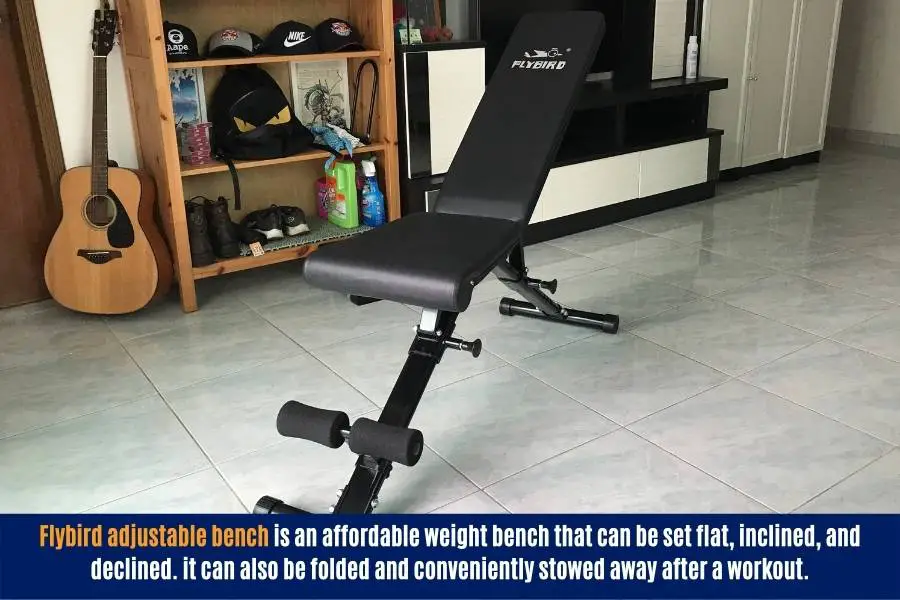
Don’t forget a bench!
These dumbbells work great with the affordable Flybird bench (you can see the reviews here) to maximize results from the bench press and fly.
And this is important for transforming a skinny chest into a killer chest!
If you like, you can check out my full Flybird folding bench review here.

The best thing about this bench is that it can also be folded.
This means you can stow it away after each workout.
If you like, you can go to my other post to find out how to build a dumbbell-only home gym (including a muscle-building workout)
Product Recap
| Product | Brand | Description | Prime | Buy |
|---|---|---|---|---|
Top Top
Top
Top
Top Top
Top
Top
Top | PowerBlock | BEST heavy adjustable dumbbell. 2.5-50lbs with the option to upgrade to 90lbs using addon-kits. | PrimeEligible | Check Amazon Price |
 Top
Top
Top
Top Top
Top
Top
Top | Yes4All | BUDGET adjustable dumbbell alternative. Up to 100lbs but with less weight increments compared to PowerBlock. | PrimeEligible | Check Amazon Price |
 Top
Top
Top
Top Top
Top
Top
Top | Flybird | Fully-adjustable flat/incline/decline weight bench to isolate different muscle regions. | PrimeEligible | Check Amazon Price |
 Top
Top
Top
Top Top
Top
Top
Top | BalanceFrom | High-density foam mat to protect your floor and bench. | PrimeEligible | Check Amazon Price |
Conclusion
I’ve explained what dumbbell weight you need to build muscle (for your specific goals)
As a beginner, a minimum dumbbell weight of 15lbs (7.5kg) is recommended for men, and 7.5lbs (4kg) is recommended for women.
But ideally, you should further double this weight to account for redundant weight for 6 months of progression.
Generally speaking though, the heavier your dumbbells, the longer they will last, and the more muscle you will build.
You can refer back to my tables to find out exactly which dumbbell weight you need to gain your desired amount of muscle!
What dumbbell weight will you be getting?
Feel free to send me a message if you have any questions! You can find my details on the “contact us” page.
You may also be interested in the downloadable Kalibre Blueprint PDF which details exactly how I gained 40lbs of lean muscle (it’s 100% free!). It details the exact exercises and nutrition (with printable worksheets) I used to go from skinny to ripped!
Thanks for reading guys!
Peace Out,
Kal
(Biochemistry BSc, Biomedical Sciences MSc, Ex-Skinny Guy)



